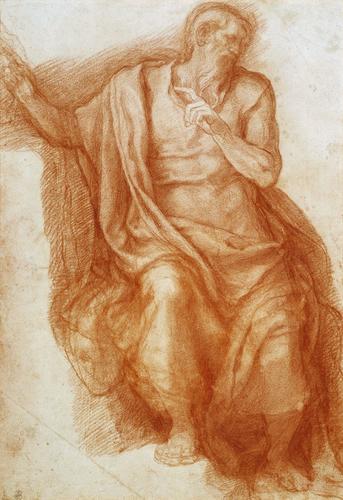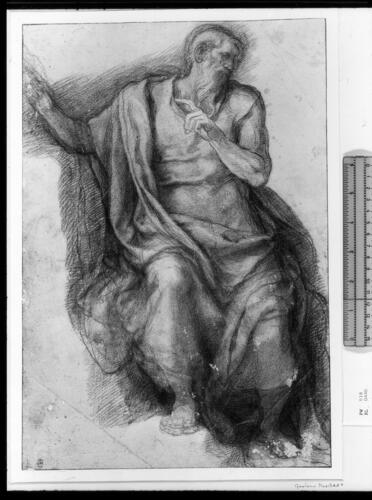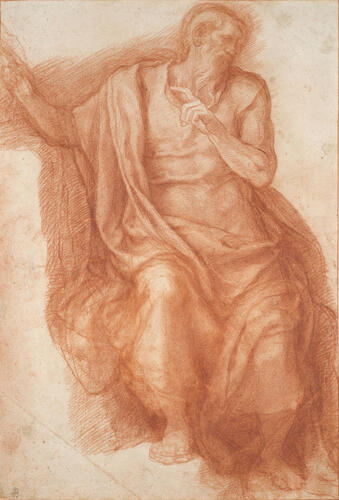-
1 of 253523 objects
St Jerome c. 1580
Red chalk, partly washed over | 39.0 x 27.6 cm (sheet of paper) | RCIN 990440

Girolamo Muziano (1532-92)
St Jerome c. 1580

Girolamo Muziano (1532-92)
St Jerome c. 1580



-
A study for Muziano’s altarpiece of St Jerome Preaching in the Wilderness, also known as the Six Hermit Saints, now in the church of Santa Maria degli Angeli, Rome.
The painting was originally executed for the Cappella Gregoriana of St Peter’s, Rome. Muziano had designed the mosaics for the chapel, executed between 1578 and 1580, and shortly after he began work on two altarpieces (the other depicting the Mass of St Basil). Borghini mentioned in 1584 that the artist had ‘in hand’ two paintings for the chapel, without stating their subjects. They were left unfinished at the artist’s death and were completed by Cesare Nebbia and Paul Bril, before being placed against the two outer faces of the great north-east pier of the crossing of St Peter’s.
During the 1720s it was decided to replace both paintings with mosaics. In 1723-4 Luigi Vanvitelli made a cartoon after the St Basil, but this was not used; instead in 1743 Pierre Subleyras was commissioned to paint a new version of the subject, and a mosaic after that painting replaced Muziano’s St Basil, which is now lost but is known from an engraving by Jacques Callot. Muziano’s St Jerome was replaced with a mosaic after Domenichino’s Last Communion of St Jerome and both Subleyras’s St Basil and Muziano’s St Jerome were transferred to the church of Santa Maria degli Angeli.
Compositional studies for the altarpiece are in the Uffizi and the Louvre, and three other studies for the figure of St Jerome are also to be found in the Louvre. One of these is drawn on the same scale as the present sheet and replicates the saint’s pose, but the drapery falls from the right shoulder across the left hip. The facial features and right hand are much clearer than here, which would usually suggest that it was a later refinement, but in fact it seems to be the earliest of the studies. In the later two studies the drapery is more summarily drawn but the sophisticated contrapposto of the painted figure is gradually developed. The pose is based on that of the prophet Ezekiel in Michelangelo’s Sistine ceiling, but the heavy, broad figural type, with drapery clinging to the surface, depends on Michelangelo’s later visual language as typified by the frescoes in the Cappella Paolina of the 1540s.
Text adapted from M. Clayton, The Art of Italy in the Royal Collection: Renaissance and Baroque, 2007Provenance
Possibly among the drawings listed in George III's Inventory A, c.1800, p. 54, 'Pellegrino Tibaldi, Primaticcio, Procaccini &c', '30 to 32. Three Drawings by Muzziano & Cangiasi'.
-
Creator(s)
-
Medium and techniques
Red chalk, partly washed over
Measurements
39.0 x 27.6 cm (sheet of paper)
Object type(s)